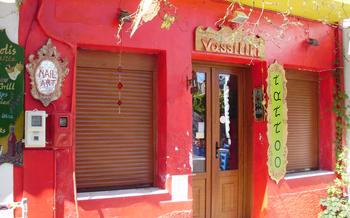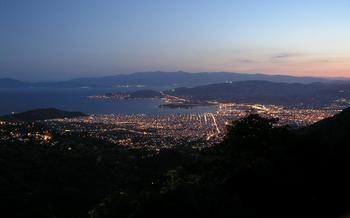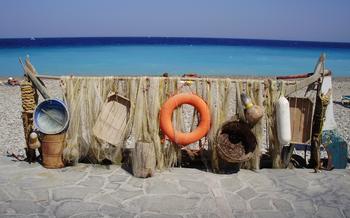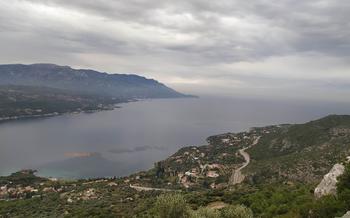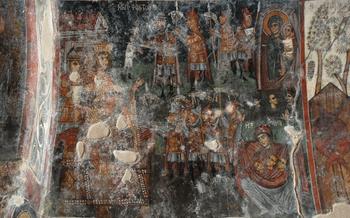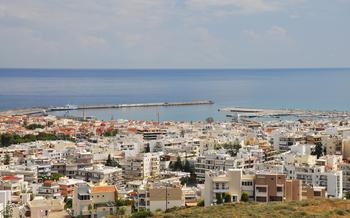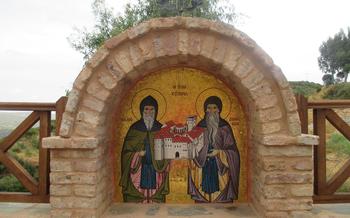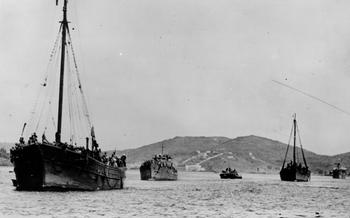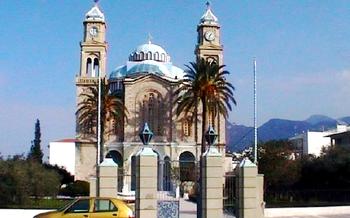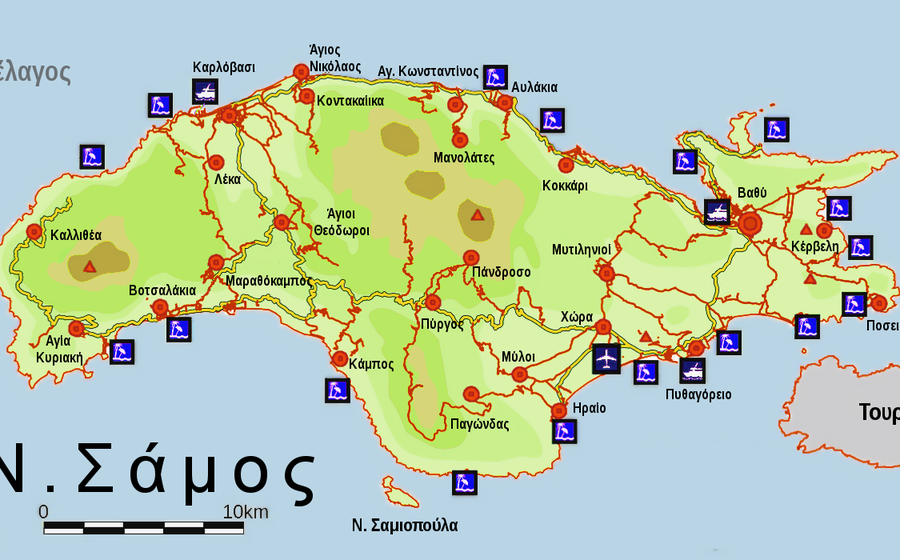
Agia Triada Monastery
- Agia Triada Monastery: A Symbol of Orthodoxy
- Location and Accessibility
- History and Origin
- Architectural Grandeur
- Religious Significance
- Must-See Icons and Relics
- Monastery Museum
- Monastic Life
- Surrounding Landscapes
- Accommodations and Amenities
- Visiting Hours and Dress Code
- Local Customs and Traditions
- Events and Festivals
- Insider Tip: Hidden Gem
Agia Triada Monastery: A Symbol of Orthodoxy
Nestled amidst the tranquil landscapes of Samos, the Agia Triada Monastery stands as a testament to the rich spiritual heritage and architectural splendor of Greece. Founded in the 16th century, this sacred sanctuary has played a pivotal role in the religious and cultural life of the island. With its stunning Byzantine architecture, awe-inspiring frescoes, and profound religious significance, the Agia Triada Monastery attracts pilgrims and visitors from around the world.
The monastery's historical significance is deeply intertwined with the history of Samos and the Orthodox Church. Over the centuries, it has weathered numerous storms, including periods of occupation and destruction. Despite these challenges, the monastery's unwavering spirit and enduring faith have allowed it to flourish and remain a beacon of hope and spirituality for generations.
Architecturally, the Agia Triada Monastery is a masterpiece of Byzantine design. Its intricate stonework, graceful arches, and domed roofs showcase the exceptional craftsmanship and artistic talent of its builders. The interior of the monastery is equally impressive, adorned with vibrant frescoes depicting biblical scenes and the lives of saints. These exquisite murals narrate the stories of faith, devotion, and the enduring power of the divine.
Beyond its architectural beauty, the Agia Triada Monastery holds immense religious importance for Orthodox Christians. It is home to a miraculous icon of the Virgin Mary, revered for its healing powers and the countless miracles it has performed. Pilgrims from far and wide flock to the monastery to seek blessings, offer prayers, and witness the divine presence that permeates its sacred spaces.
Location and Accessibility
The Agia Triada Monastery is conveniently situated in the village of Agia Triada, just a short distance from the main road that connects Samos Town with Karlovasi. To reach the monastery by car, simply follow the signs from either direction. There is ample parking space available for visitors, ensuring a hassle-free arrival.
Alternatively, if you prefer public transportation, you can catch a bus from Samos Town or Karlovasi to Agia Triada village. The bus stop is located near the monastery, making it easy to access.
For those interested in a more immersive experience, guided tours are available upon request. These tours provide an in-depth exploration of the monastery's history, architecture, and religious significance. Visitors can gain valuable insights and a deeper understanding of this sacred place.
History and Origin
The founding of the Agia Triada Monastery dates back to the 16th century, during the flourishing era of the Byzantine Empire. According to local legends, a devout monk named Father Ioannis was guided by a divine vision to establish a religious sanctuary atop the hill of Karvounis. With the support of the local community, the construction of the monastery began, and over the years, it grew into a significant center of Orthodox Christianity.
Throughout its history, the monastery has witnessed numerous pivotal events that shaped its identity. In the 17th century, it underwent extensive renovations and expansions, resulting in the architectural marvels we see today. During the Ottoman occupation, the monastery served as a refuge for persecuted Christians, providing spiritual solace and protection. Its strategic location allowed it to resist attacks and maintain its autonomy, becoming a symbol of resilience and faith.
The influence of the Byzantine Empire is deeply embedded in the Agia Triada Monastery's history and architecture. The intricate frescoes adorning the interior walls depict scenes from the Bible and the lives of saints, showcasing the artistic prowess of Byzantine masters. The monastery's layout, with its central courtyard surrounded by arched corridors, is reminiscent of other Byzantine monasteries from the same era. These elements collectively contribute to the rich cultural and historical heritage of the site.
Architectural Grandeur
The Agia Triada Monastery stands as a testament to the architectural prowess of its builders. Its exterior design exudes a sense of serenity and simplicity, with whitewashed walls and arched windows blending harmoniously with the surrounding landscape. The layout of the monastery follows the traditional Byzantine style, featuring a central courtyard surrounded by various buildings, including the church, living quarters, and refectory.
Stepping inside the monastery, visitors are greeted by a breathtaking display of interior decorations and frescoes. The walls and ceilings are adorned with intricate paintings depicting biblical scenes, saints, and angels. The vibrant colors and meticulous attention to detail create a sense of awe and reverence within the sacred space.
One of the most striking features of the monastery is its iconic bell tower. Soaring high above the surrounding structures, the bell tower serves as a beacon of faith and a symbol of the monastery's presence in the region. Its intricate carvings and delicate arches add a touch of elegance to the overall design.
While each monastery in Greece possesses its own unique architectural style, the Agia Triada Monastery shares certain similarities with other notable monasteries in the country. The use of whitewashed walls, arched windows, and domed roofs is a common feature found in many Byzantine monasteries, creating a sense of unity and shared heritage.
Religious Significance
The Agia Triada Monastery holds immense religious significance as a sacred place of worship for Orthodox Christians. Pilgrims from all corners of Greece and beyond flock to the monastery to seek spiritual guidance, pray for miracles, and pay homage to the miraculous icon of the Virgin Mary. The monastery is a living testament to the deep faith and devotion of the Greek people.
Throughout the year, the monastery hosts various religious celebrations and festivals that attract thousands of visitors. The most notable of these is the annual feast of the Assumption of the Virgin Mary, held on August 15th, which draws pilgrims from all over the country. During this time, the monastery is adorned with colorful decorations, and special services and processions are held.
Beyond its role as a pilgrimage site, the monastery also plays a vital role in the local community. The monks provide spiritual guidance and support to the surrounding villages, and the monastery often serves as a gathering place for religious and social events. The monastery's presence has shaped the cultural and spiritual identity of the region, making it a beacon of faith and community.
Must-See Icons and Relics
The Agia Triada Monastery is home to a collection of remarkable icons and relics that hold immense religious significance for Orthodox Christians. The most revered icon is that of the Virgin Mary, believed to be miraculous and possessing the power to grant wishes and heal the sick. Pilgrims from far and wide flock to the monastery to pay homage to this sacred icon and seek its blessings.
Another notable icon is that of Saint Triada, the patron saint of the monastery. This icon is said to have been painted by Saint Luke the Evangelist himself and is considered to be one of the most valuable relics in the monastery's possession. The icon is believed to have miraculous powers and is often sought after for healing and protection.
In addition to these icons, the monastery also houses a collection of relics associated with various saints and martyrs. These relics, which include bones, fragments of clothing, and personal belongings, are believed to possess spiritual power and are venerated by the faithful. Visitors can view these relics in a special display within the monastery, where they are presented with reverence and respect.
The iconostasis, or screen that separates the sanctuary from the nave of the church, is another highlight of the monastery's interior. Intricately carved from wood and adorned with gold leaf, the iconostasis features a series of icons depicting scenes from the Bible and the lives of saints. These icons are considered masterpieces of Byzantine art and are a testament to the skill and devotion of the artists who created them.
Monastery Museum
Within the sacred walls of the Agia Triada Monastery, a treasure trove of religious artifacts and historical documents awaits discovery at the monastery museum. This repository of faith and heritage invites visitors to delve deeper into the monastery's rich past and the profound impact it has had on the region.
Exhibits showcasing intricate religious artifacts, such as ornate chalices, finely crafted crosses, and shimmering vestments, provide a glimpse into the monastery's devotion and artistry. Historical documents, including ancient manuscripts and chronicles, offer insights into the monastery's founding, its trials and tribulations, and its enduring legacy.
The museum also houses a collection of relics, each with its own captivating story. These sacred objects, revered for their connection to saints and miracles, evoke a sense of awe and reverence among visitors. The iconostasis, the intricately carved wooden screen that separates the altar from the nave, stands as a masterpiece of craftsmanship, adorned with resplendent icons that depict scenes from the Bible and the lives of saints.
Admission to the museum is nominal, and visitors are encouraged to take their time exploring its fascinating exhibits. The museum's knowledgeable staff is on hand to answer questions and provide additional insights into the monastery's history and significance.
Monastic Life
Within the walls of the Agia Triada Monastery, a vibrant community of monks dedicates their lives to prayer, contemplation, and service. Their daily routine revolves around a strict schedule of worship, study, and work. At dawn, the monks gather in the church for morning prayers, setting the tone for the day's spiritual journey. Throughout the day, they engage in various tasks, from tending to the monastery's gardens and orchards to crafting intricate religious artifacts.
Prayer and contemplation form the cornerstone of monastic life. The monks spend hours in silent meditation, seeking communion with the divine. Through prayer, they strive to purify their hearts, cultivate humility, and deepen their understanding of God's teachings.
The monastery operates on principles of self-sufficiency and sustainability. The monks cultivate their own food, raise livestock, and produce traditional handicrafts. This self-reliant lifestyle allows them to maintain their independence and contribute to the monastery's upkeep.
Visitors to the monastery have the opportunity to interact with the monks and gain insights into their unique way of life. Through conversations and guided tours, the monks share their experiences, beliefs, and the rich history of the monastery. These interactions offer a glimpse into the spiritual and cultural heritage that thrives within these sacred walls.
Surrounding Landscapes
The Agia Triada Monastery is nestled amidst a breathtaking natural landscape that complements its spiritual aura. From the monastery's vantage point, visitors can bask in panoramic views of the Aegean Sea, with shimmering turquoise waters stretching as far as the eye can see. The surrounding area is a treasure trove of natural wonders, inviting visitors to explore the diverse flora and fauna that thrive in this region.
Hiking enthusiasts will find solace in the network of well-marked trails that crisscross the picturesque surroundings of the monastery. These trails offer varying levels of difficulty, catering to both experienced hikers and those seeking a leisurely stroll amidst nature's tranquility. Along the way, hikers can encounter hidden coves, secluded beaches, and cascading waterfalls, each offering a unique perspective of the region's natural beauty.
Adventurous souls can embark on invigorating mountain biking excursions, traversing rugged terrain and discovering hidden gems off the beaten path. The surrounding countryside boasts numerous cycling routes suitable for riders of all skill levels, providing an exhilarating experience amidst breathtaking scenery.
For those seeking a more relaxed encounter with nature, leisurely walks through the olive groves surrounding the monastery offer a tranquil escape. Visitors can meander through the rows of ancient olive trees, marveling at their gnarled trunks and silvery-green leaves. The air is perfumed with the heady scent of olives, creating a serene atmosphere conducive to contemplation and introspection.
Whether it's hiking, mountain biking, or leisurely walks through olive groves, the natural surroundings of the Agia Triada Monastery offer a harmonious blend of spiritual and physical rejuvenation, leaving visitors with a lasting sense of peace and serenity.
Accommodations and Amenities
The Agia Triada Monastery offers basic accommodations for pilgrims and visitors seeking a deeper spiritual experience. Guesthouses within the monastery provide simple yet comfortable rooms, allowing guests to immerse themselves in the tranquil atmosphere. These guesthouses often have shared facilities and are available at a modest cost.
For those seeking a more immersive experience, the monastery also offers opportunities for retreats and workshops. These programs provide a unique chance to learn about Orthodox traditions, engage in spiritual practices, and connect with the monastic community.
Dining options at the monastery are limited but offer a taste of traditional Greek cuisine. Visitors can enjoy simple, wholesome meals prepared with fresh, local ingredients. The monastery's dining hall provides a communal space for pilgrims to share meals and engage in meaningful conversations.
It's important to note that the monastery's amenities are basic and focused on facilitating a spiritual journey rather than providing luxurious accommodations. Visitors should come prepared for a simple and serene experience, embracing the opportunity to disconnect from worldly distractions and connect with their inner selves.
Visiting Hours and Dress Code
To ensure a respectful and harmonious visit, appropriate attire is expected within the monastery's sacred grounds. Visitors should dress modestly, with covered shoulders and knees. Shorts, tank tops, and revealing clothing are discouraged. This dress code reflects the monastery's religious significance and helps maintain a serene atmosphere.
Photography and videography are permitted within the monastery, but flash photography is strictly prohibited to preserve the integrity of the icons and frescoes. Visitors are encouraged to capture the beauty of the monastery without disturbing the tranquility of the monks or other visitors.
The recommended time to visit the Agia Triada Monastery is during the morning hours, when the natural light illuminates the monastery's stunning architecture and frescoes. Visitors can avoid the midday heat and crowds by arriving early, allowing ample time to explore the monastery's various sections and soak in its spiritual ambiance.
Local Customs and Traditions
When visiting the Agia Triada Monastery, it is important to be aware of and respectful of local customs and traditions. As a pilgrimage site for Orthodox Christians, the monastery holds a deep religious significance, and visitors should conduct themselves accordingly. Appropriate attire is expected, with shoulders and knees covered. It is customary to remove hats and sunglasses when entering the church.
Interacting with the local community requires sensitivity and respect. Greetings are typically warm and friendly, and a smile goes a long way. It is polite to learn a few basic Greek phrases, such as "hello" (γεια σας, pronounced "yassas") and "thank you" (ευχαριστώ, pronounced "efharisto").
Respecting religious practices and beliefs is essential. Avoid loud talking or disruptive behavior during services or ceremonies. Photography and videography are permitted in most areas, but it is important to ask for permission before taking photos of people or religious objects.
Understanding and observing local customs and traditions not only shows respect but also enhances the overall experience. Visitors who make an effort to immerse themselves in the local culture will find their visit to the Agia Triada Monastery to be a truly enriching and meaningful one.
Events and Festivals
The Agia Triada Monastery hosts several annual celebrations and festivals that draw pilgrims and visitors from around the world. These events showcase the rich religious traditions and cultural heritage of the monastery.
One of the most significant events is the feast day of the monastery's patron saint, Agia Triada (Holy Trinity), celebrated on June 11th. During this festival, grand religious processions, accompanied by traditional Greek music and dance, fill the monastery grounds with a vibrant atmosphere.
The monastery also celebrates the feast day of the Assumption of the Virgin Mary on August 15th, with processions, prayers, and special services. This event attracts many pilgrims who come to pay homage to the miraculous icon of the Virgin Mary, believed to have healing powers.
Throughout the year, the monastery hosts various other religious festivals, such as Easter, Christmas, and Epiphany. These celebrations offer visitors a glimpse into the deep spirituality and faith that permeate the monastery's atmosphere.
Participating in these events is a unique way to experience the vibrant traditions and customs of the Greek Orthodox Church. Visitors can join in the processions, listen to Byzantine chant music, and witness the fervor of the local community during these special occasions.
Insider Tip: Hidden Gem
Beyond the main attractions of the Agia Triada Monastery, there lies a hidden gem waiting to be discovered. Tucked away in a secluded corner of the complex is a small chapel known as the Chapel of the Holy Cross. This unassuming chapel holds a remarkable treasure – a beautifully preserved 16th-century fresco depicting the crucifixion of Jesus Christ. The fresco is a masterpiece of Byzantine art, with vibrant colors and intricate details that bring the scene to life. It is a testament to the artistic skill and devotion of the monks who created it.
For those who seek a deeper connection with the monastery's spiritual heritage, the Chapel of the Holy Cross offers a unique opportunity for contemplation and reflection. The serene atmosphere and the powerful imagery of the fresco create a sense of awe and reverence that is sure to leave a lasting impression.
